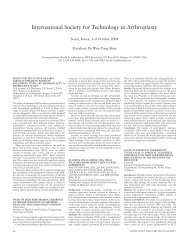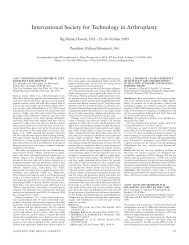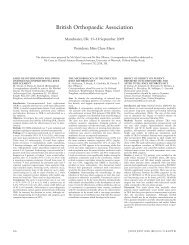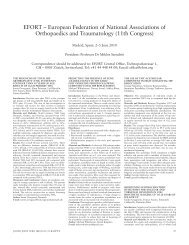Procs III 2011.indb - Journal of Bone & Joint Surgery, British Volume ...
Procs III 2011.indb - Journal of Bone & Joint Surgery, British Volume ...
Procs III 2011.indb - Journal of Bone & Joint Surgery, British Volume ...
Create successful ePaper yourself
Turn your PDF publications into a flip-book with our unique Google optimized e-Paper software.
360 HELLENIC ASSOCIATION OF ORTHOPAEDIC SURGERY AND TRAUMATOLOGY<br />
124 FACTORS WITH A FAVOURABLE<br />
IMPACT REGARDING THE SURGICAL<br />
TREATMENT OF LEGG-CALVE PERTHES<br />
DISEASE IN CHILDREN<br />
I. Flieger, N. Pettas, A. Leonidou, N. Liarakos, I.<br />
Platanitis, O. Leonidou<br />
Orthopaedic Department, Childrens Hospital<br />
“Agia S<strong>of</strong>ia”<br />
The cause <strong>of</strong> Legg-Calve Perthes disease, 97 years after<br />
its original description remains undefi ned. In the present<br />
study we examined factors, which were correlated<br />
with a favourable or negative impact on the outcome <strong>of</strong><br />
surgical treatment.<br />
From a total <strong>of</strong> 98 children, treated during the period<br />
1994-2006, we studied 20 cases (classifi ed as Catterall<br />
<strong>III</strong> and IV), treated surgically. The average age was 7.4<br />
years (4-13 years). We studied in comparison the most<br />
common procedures performed: these were the varus<br />
femoral osteotomy (12) and the lateral shelf acetabuloplasty<br />
(7). The subtrochanteric osteotomy yielded superior<br />
radiological results Stuhlberg I-II (I:6, II:6), than the<br />
lateral shelf procedure Stuhlberg II-IV (II:3,<strong>III</strong>:3,IV:1).<br />
The clinical results were similar between the two groups<br />
according to the Barrett scale, excellent or good.<br />
Regarding the subtrochanteric osteotomy the most<br />
important factor was the precise varisation <strong>of</strong> the femoral<br />
neck and secondly the timing <strong>of</strong> surgical treatment<br />
early during the fragmentation stage <strong>of</strong> the disease,<br />
before the femoral head is signifi cantly distorted. The<br />
most important positive factor regarding the lateral<br />
shelf procedure appears to be the accuracy <strong>of</strong> the surgical<br />
technique, in order that the graft coverage <strong>of</strong> the<br />
femoral head is accurately placed on the hip capsule.<br />
Negative factor for the lateral shelf procedure in one<br />
case was early weightbearing, which resulted in collapsing<br />
<strong>of</strong> the femoral head. It appears that with extensive<br />
necrosis (Caterall IV) the femoral head isn’t biomechanically<br />
enough resistant with this procedure to resist loads<br />
that result from early ambulation.<br />
001 COMPUTER-ASSISTED THREE-<br />
DIMENSIONAL CORRELATION BETWEEN<br />
THE FEMORAL NECK-SHAFT ANGLE<br />
AND THE OPTIMAL ENTRY POINT FOR<br />
ANTEGRADE NAILING<br />
G. Anastopoulos, D. Chissas, J. Dourountakis,<br />
P.G. Ntagiopoulos,G. Stamatopoulos, N.<br />
Zacharakis, A. Asimakopoulos,Th.A. Xenakis<br />
2nd Dpt. <strong>of</strong> Orthopaedic & Trauma <strong>Surgery</strong>,<br />
“G. Gennimata” Hospital <strong>of</strong> Athens, Greece;<br />
Dpt. <strong>of</strong> Orthopaedic <strong>Surgery</strong>, University Hospital<br />
<strong>of</strong> Ioannina, University <strong>of</strong> Ioannina School <strong>of</strong><br />
Medicine, Ioannina, Greece.<br />
Optimal entry point for antegrade femoral intramedullary<br />
nailing (IMN) remains controversial in the current<br />
medical literature. The defi nition <strong>of</strong> an ideal entry point<br />
for femoral IMN would implicate a tenseless introduction<br />
<strong>of</strong> the implant into the canal with anatomical alignment<br />
<strong>of</strong> the bone fragments. This study was undertaken<br />
in order to investigate possible existing relationships<br />
between the true 3D geometric parameters <strong>of</strong> the femur<br />
and the location <strong>of</strong> the optimum entry point.<br />
A sample population <strong>of</strong> 22 cadaveric femurs was used.<br />
Computed-tomography sections every 0.5 mm for the<br />
entire length <strong>of</strong> femurs were produced. These sections<br />
were subsequently reconstructed to generate solid computer<br />
models <strong>of</strong> the external anatomy and medullary<br />
canal <strong>of</strong> each femur. Solid models <strong>of</strong> all femurs were subjected<br />
to a series <strong>of</strong> geometrical manipulations and computations<br />
using standard computer-aided-design tools.<br />
In the sagittal plane, the optimum entry point always<br />
lied a few millimeters behind the femoral neck axis<br />
(mean=3.5±1.5 mm). In the coronal plane the optimum<br />
entry point lied at a location dependent on the femoral<br />
neck-shaft angle. Linear regression on the data showed<br />
that the optimal entry point is clearly correlated to the<br />
true 3D femoral neck-shaft angle (R2=0.7310) and the<br />
projected femoral neck-shaft angle (R2=0.6289). Anatomical<br />
parameters <strong>of</strong> the proximal femur, such as the<br />
varus-valgus angulation, are key factors in the determination<br />
<strong>of</strong> optimal entry point for nailing.<br />
The clinical relevance <strong>of</strong> the results is that in varus<br />
hips (neck-shaft angle ≤ 120o) the correct entry point<br />
should be positioned over the trochanter tip and the<br />
use stiff nails is advised. In cases <strong>of</strong> hips with neck-shaft<br />
angle between 120o and 130o, the optimal entry point<br />
lies just medially to the trochanter tip (at the piriformis<br />
fossa) and the use <strong>of</strong> stiff implants is safe. In hips with<br />
neck-shaft angle over 130o the anatomical axis <strong>of</strong> the<br />
canal is medially to the base <strong>of</strong> the neck, in a “restricted<br />
area”. In these cases the entry point should be located<br />
at the insertion <strong>of</strong> the piriformis muscle and the application<br />
<strong>of</strong> more malleable implants that could easily follow<br />
the medullary canal should be considered.<br />
002 FLOW CYTOMETRY LEUKOCYTE<br />
IMMUNOPHENOTYPE INVESTIGATION IN<br />
TOTAL HIP ARTHROPLASTY LOOSENING<br />
M. Ovrenovits, E.E. Pakos, G. Vartholomatos,<br />
G.I. Mitsionis<br />
Haematology Laboratory – Unit <strong>of</strong> Molecular<br />
Biology, University Hospital <strong>of</strong> Ioannina;<br />
Department <strong>of</strong> Orthopaedic <strong>Surgery</strong>, University<br />
Hospital <strong>of</strong> Ioannina; University <strong>of</strong> Ioannina,<br />
School <strong>of</strong> Medicine, Ioannina, Greece<br />
The aim <strong>of</strong> the study to analyze the circulating white<br />
blood cells including the intensity expression <strong>of</strong> surface<br />
receptors and cytoplasmic molecules in patients underwent<br />
total hip replacement, with either aseptic or septic<br />
loosening <strong>of</strong> hip prostheses in order to identify cell-surface<br />
and cytoplasmic markers that could be indicative<br />
<strong>of</strong> early loosening. Flow cytometry was performed in<br />
whole peripheral blood samples <strong>of</strong> 20 patients with<br />
loosening (10 septic and 10 aseptic). Ten healthy individuals<br />
served a control group. The CD62L, CD18,<br />
CD11a, CD11b and CD11c expressions were evaluated.<br />
The mean fl uorescence intensity (MFI) <strong>of</strong> CD 18<br />
was decreased on all leukocytes subsets compared to<br />
control group. For patients with aseptic loosening we<br />
demonstrated an increase <strong>of</strong> MFI for CD11b in granulocytes<br />
and for CD11c in monocytes and granulocytes<br />
compared to control group. In patients with septic loosening<br />
an increase <strong>of</strong> MFI for CD 11c was observed in<br />
monocytes compared to control group. The comparison<br />
between aseptic and septic loosening showed a statistically<br />
signifi cant lower CD18 MFI value in granulocytes<br />
for aseptic loosening. A trend towards lower MFI<br />
values <strong>of</strong> CD 62L in lymphocytes and granulocytes were<br />
observed in aseptic but not in septic loosening patients<br />
compared to control group. The present study is the fi rst<br />
study in published literature to demonstrate cell surface<br />
and cytoplasmic markers in peripheral blood indicative<br />
<strong>of</strong> loosening <strong>of</strong> THAs by means <strong>of</strong> fl ow cytometry.<br />
003 THE INFLUENCE OF PRP ON TENDON<br />
HEALING. AN EXPERIMENTAL STUDY IN<br />
RABBITS<br />
K. Kazakos, D. Lyras, D. Verettas, A.<br />
Polychronidis, S. Botaitis, G. Agrogiannis<br />
Democritus University <strong>of</strong> Thrace, Orthopaedic<br />
Clinic<br />
We investigated the effect <strong>of</strong> Platelet Rich Plasma (PRP)<br />
in tendon healing. The aim was to assess the effect <strong>of</strong> an<br />
application <strong>of</strong> PRP on angiogenesis and immunohistochemical<br />
expression <strong>of</strong> TGF-b1 and IGF-I during tendon<br />
healing.We used a patellar tendon defect model after<br />
resecting its central portion. 48 skeletally mature New<br />
Zealand White rabbits were divided into the respective<br />
group and each group they were randomised into controls<br />
and PRP treated cases. The rabbits were sacrifi ced at<br />
weekly intevals and histological and immunohistological<br />
assessments were performed. The results showed a faster<br />
healing rate, increased vascularity, and higher expression<br />
<strong>of</strong> the growth factors in the PRP group. We conclude<br />
that the mixture <strong>of</strong> growth factors present in PRP gel<br />
improved the rate and quality <strong>of</strong> tendon healing.<br />
004 IS TUMOR RESPONSE TO<br />
PREOPERATIVE CHEMOTHERAPY A SOLE<br />
PROGNOSTIC FACTOR OF SURVIVAL IN<br />
OSTEOSARCOMA PATIENTS?<br />
M. Ioannou, I. Papanastassiou, S. Kottakis, N.<br />
Demertzis<br />
Department <strong>of</strong> Orthopaedics, METAXA<br />
Anticancer Hospital<br />
In the treatment <strong>of</strong> osteosarcoma, many reports in the<br />
literature outline that tumor response to chemotherapy<br />
directly correlates with disease-free survival and/or mortality.<br />
The aim <strong>of</strong> this study is to evaluate if the percentage<br />
<strong>of</strong> tumor necrosis is a sole prognostic indicator <strong>of</strong><br />
overall survival in osteosarcoma patients.<br />
We retrospectively studied 33 osteosarcoma cases<br />
treated in our institution from 1997 to 2006. All<br />
patients were treated preoperatively with HDMTX chemotherapy.The<br />
percent necrosis <strong>of</strong> the excised specimen<br />
were compared with survival rates <strong>of</strong> the patients.<br />
Sixteen patients were good responders (Huvos<br />
<strong>III</strong>,IV- >90% necrosis), 16 patients were poor responders<br />
(Huvos I,II- < 90% necrosis), and one patient died<br />
during preop. chemotherapy.With a mean follow-up <strong>of</strong><br />
5,48 years (3-12 years) 22 patients are NOD (not evident<br />
disease), in 8 patient disease progressed, 8 patients died.<br />
Statistical analysis could not establish a signifi cant correlation<br />
between percent necrosis and patient survival.<br />
Outcome <strong>of</strong> osteosarcoma may be dependent on a<br />
variety <strong>of</strong> factors s.a. tumor size, location, metastasis,<br />
surgical therapy, pathologic fracture. Tumor necrosis<br />
itself may be dependent on the histological subtype <strong>of</strong><br />
the tumor and P-glycoprotein expression. In this series<br />
we could not establish tumor necrosis as a sole prognostic<br />
factor <strong>of</strong> patient survival.<br />
00 LOW-DENSITY LIPOPROTEIN RECEPTOR-<br />
RELATED PROTEIN 5 (LRP5) GENE<br />
EXPRESSION IN HUMAN OSTEOARTHRITIC<br />
CHONDROCYTES<br />
A. Tsezou, I. Papathanasiou, T. Orfanidou, K.N.<br />
Malizos<br />
University <strong>of</strong> Thessaly, Medical School,<br />
Laboratory <strong>of</strong> Cytogenetics and Molecular<br />
Genetics, Larissa, Greece; University <strong>of</strong> Thessaly,<br />
Medical School, Department <strong>of</strong> Orthopaedics,<br />
Larissa, Greece; Institute for Biomedical Research<br />
and Technology, Larissa, Greece; University <strong>of</strong><br />
Thessaly, Medical School, Department <strong>of</strong> Biology,<br />
Larissa, Greece<br />
The Wnt/b-catenin signaling pathway participates in<br />
normal adult bone and cartilage biology and seems to be<br />
involved in cartilage degeneration and subsequent OA<br />
progression. The aim <strong>of</strong> this study was to investigate<br />
the activation <strong>of</strong> Wnt/b-catenin pathway in osteoarthritis<br />
and the role <strong>of</strong> LRP5, a coreceptor <strong>of</strong> Wnt/b-catenin<br />
pathway, in human osteoarhritic chondrocytes.<br />
Human cartilage was obtained from 11 patients with<br />
primary osteoarthritis (OA) undergoing total knee and<br />
hip replacement surgery. Normal cartilage was obtained<br />
from 5 healthy individuals. b-catenin and LRP5 mRNA<br />
and protein levels were investigated using real time<br />
PCR and western blot analysis, respectively. Blocking<br />
LRP5 expression was performed using small interfering<br />
(siRNA) against LRP5 and subsequent MMP-13 mRNA<br />
and protein levels were evaluated by real time RCR and<br />
western blot analysis, respectively.<br />
We confi rmed the activation <strong>of</strong> Wnt/b-catenin pathway<br />
in osteoarthritis, as we observed signifi cant upregulation <strong>of</strong><br />
b-catenin mRNA and protein expression in osteoarthritic<br />
chondrocytes. We also observed that LRP5 mRNA and<br />
protein expression was signifi cantly up-regulated in osteoarthritic<br />
cartilage compared to normal. Also, blocking LRP5<br />
expression using siRNA against LRP5 resulted in a signifi -<br />
cant decrease in MMP-13 mRNA and protein expressions.<br />
Our fi ndings suggest that the upregulation <strong>of</strong> LRP5<br />
mRNA and protein expression in osteoarthritic chondrocytes<br />
results in an increased activation <strong>of</strong> Wnt/b-catenin<br />
pathway in osteoarthritis. The observed reduction <strong>of</strong> MMP-<br />
13 expression after blocking LRP5 expression in osteoarthritic<br />
chondrocytes, suggests the involvement <strong>of</strong> LRP5 in<br />
the progression and pathogenesis <strong>of</strong> osteoarthritis.<br />
J BONE JOINT SURG [BR] 2011; 93-B:SUPP <strong>III</strong>








